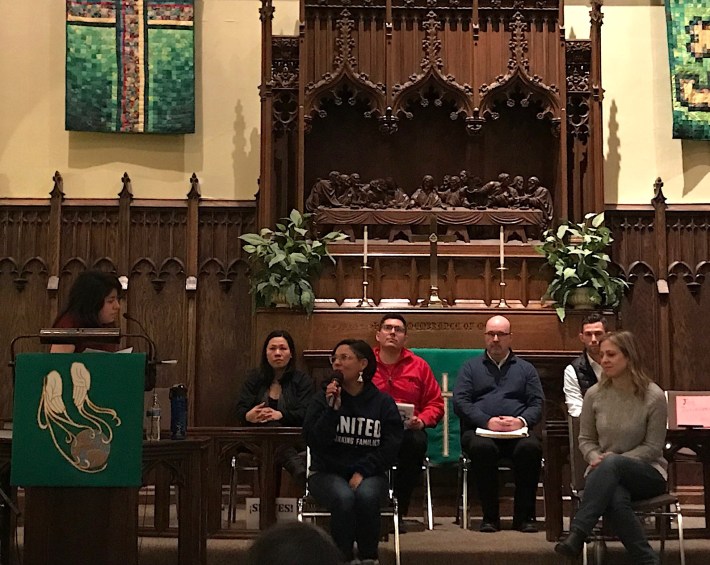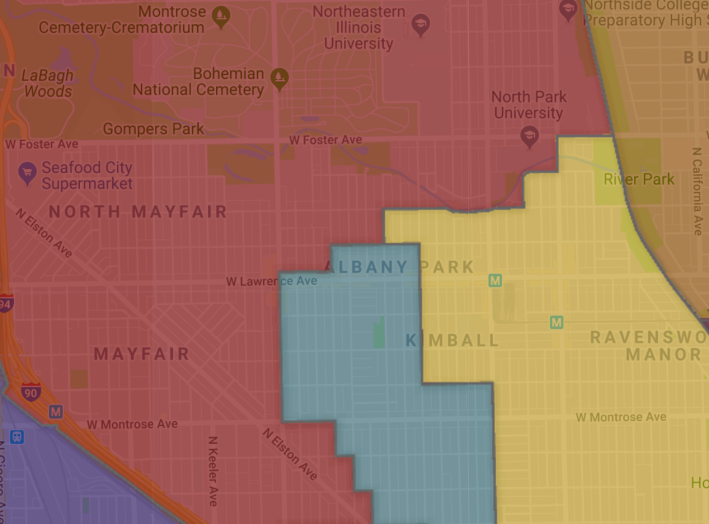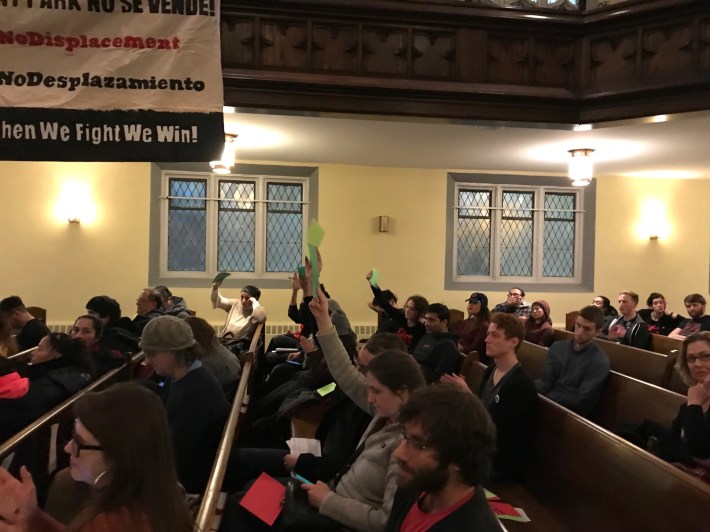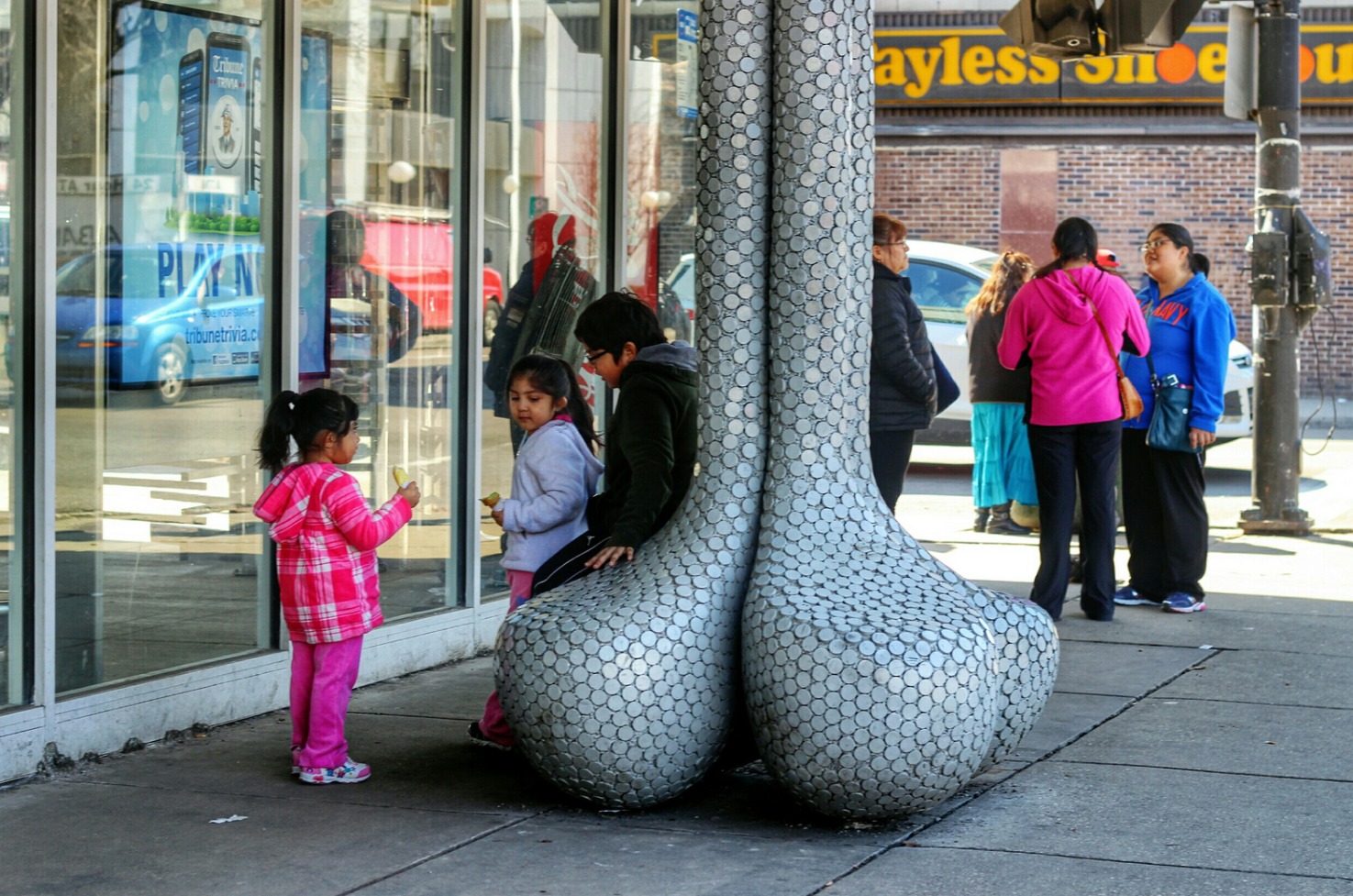On Saturday afternoon, Streetsblog reporter Lynda Lopez moderated an Albany Park candidates forum at Christ Lutheran Church, featuring several local aldermanic hopefuls. These included community organizer Rossana Rodriguez and startup professional Katie Sieracki, who hope to unseat 33rd Ward incumbent Deb Mell, who didn’t attend the panel. From the 35th Ward race, current alderman Carlos Ramirez-Rosa and challenger Amandy Yu Dieterich, a business owner, were present. Also in attendance were architect Robert Murphy and Casey Smagala, from Albany Park Community Center, who are vying to replace incumbent 39th Ward alderman Margaret Laurino, who’s not seeking reelection.
While the forum focused on affordable housing, gentrification and displacement, the candidates also responded to questions from the audience. Here are their responses to my question, “What would you do to improve transportation access for low-income and working class residents in Albany Park?”

Rossana Rodriguez: I was saying before, we have a lot of wealth in this city. I feel that people that can’t afford to pay for public transit should be able to just use public transit, right? [Applause.] And we have the money, we have the resources to be able to pay for that. We just decide not to do it. It’s a choice that we make. When we make a budget, we make choices of how we use the money, right? If we are talking about giving a billion dollars in [tax-increment financing] money to a developer, then we are making a very clear choice about how we want to use our resources. So that’s one thing.
I also think that we need to expand our public transit, particularly close to and in the 33rd Ward. We should be talking about bringing back the Kedzie bus. There are a lot of senior housing buildings along Kedzie Avenue and they don’t have bus access through there. That’s a really big problem. Same with Elston, same with going further up California. [The northern terminus of the California Avenue bus line is at Roscoe Avenue.] So extending public transportation.
I took the train every day to go downtown, and it should also be more constant, because it is actually a lot of times a hassle for working people to use public transportation.
Amanda Yu Dieterich: I think it’s important that we understand how CTA decides transportation. It’s based on ridership. So that means, as an elected official, when we want a bus line to happen, like the Elston bus, that we outreach actively, and ask the community to come and ride our buses, so that we are actually making accessible transportation for everyone. And we also need to identify where senior housing is, where there are large densities of apartments and homes, so that we are placing bus stops where it’s convenient to walk to, and making sure that we are increasing ridership that way, so that there’s accessibility in these areas.
And furthermore, we need to fix those streets. We need to figure out how we can get funding to fix the streets, so that buses are riding on roads that are passable, and bikes are riding on streets that are safe. I think it’s very important that when we talk about transportation and accessibility, we are looking at it holistically, we are looking at traffic modes and how people are using it, and making sure that we’re aware of all of that.

Carlos Ramirez-Rosa: In the old days when I was a congressional page in the offices of Congressman Luis Gutierrez, I worked on education issues. And one day a mother comes into the office and she says, “I need your help transferring my son from the school that he’s at to the neighborhood high school closest to our home.” So I said, “What school is your son at?” And she said, “He’s at Lane Tech.” So I asked her what school she wanted him transferred to, and she mentions a school that I’m not going to mention by name, but that doesn’t have the best reputation. And I said, “Señora, I think the reason that the principal doesn’t want to let you transfer your son is because Lane Tech is an amazing school, one of the top schools in the city, and the principal knows that and wants to keep your son there.” And she goes, “Oh no, I know, it’s just that I can’t afford the bus fare every single day to get my son to and from school, so that’s why I’d like him to be able to go the school closest to us.”
So these are these are the challenges that we face. I think it’s time that we assess the Ventra system, which has not been working for working-class Chicagoans. I think that it’s also time that we find a way to subsidize bus fares, to make it more affordable for our students and our working families. [Applause.] But that also means that raising the minimum wage to $15 an hour.
That also means ensuring that we also are expanding bike lanes, that we also are expanding those opportunities. I’ve had the opportunity to work with [the Chicago Department of Transportation] to do that, I’ve tried to accomplish that, balancing those priorities and always moving in community input. Some year ago through participatory budgeting we put a project in for bike lanes. Unfortunately the community voted it down. But I also worked to expand Divvy bike stations, working with CDOT and working with small business owners to make that happen.
Robert Murphy: We have to be looking at all transit options. We need to expand the ability to have safe lanes for bikes. We have to also look at, as Amanda was saying, bringing back something like the Elston bus would really be great for the ward, especially for seniors who have relied on this.
And we have to look at opportunities that we have in our ward for having more development around transportation hubs, because that’s something that we need to push more, to make sure that we’re utilizing these assets that we have in our community.
I think that it’s also really important that we continue to push CTA to be more efficient. There’s too much money being wasted on patronage contracts and things being done that aren’t really affecting anything, rather than going into capital development, and finding new ways, like more efficient buses and such, so that they can afford to run some of these smaller routes. So we need to push our transportation system here in the city to be more efficient and also to be more technology-forward, to make sure that people are able to get to where they need to go more easily.

Casey Smagala: The conversation around public transportation isn’t politics to me, it’s personal. I have never owned a car while I’ve lived in the city of Chicago. I’m a Brown Line commuter if I’m heading [downtown], and I’m on the Lawrence bus just about every day.
Public transportation is a public right, and we need to fully fund it. Some of the things that I think would strengthen public transportation, I’d actually work with the next mayor and the 33rd Ward. We need to make a better connectivity between the Kimball bus, the Brown Line, and the Kedzie bus, going across on Foster there. The overhang doesn’t actually protect us from the elements… Families should have an easier time coming across our wards, because I don’t just think about the ‘L’ line, I think about the cross-town lines. We need to find the funding and get a community plan to make the transition to the Brown Line much more convenient for riders.
In addition to that, I agree with my colleagues here, we need to bring back our Elston bus, with a protected bike lane. Elston’s a great corridor to get downtown. I use it regularly as an avid cyclist; that’s how I bike into the city. But I’d like to see us follow the Copenhagen model. You’ll see this on Broadway in Uptown, we have a line of parked cars actually protecting the cyclists.
The third thing that we need to do, when looking at public transportation, is look at our connectivity points between public transportation and cyclists. Do they have bike racks? Do they have [wayfinding signs], so we can make the transition simple and easy for riders.
Katie Sieracki: I love that we’re talking transportation today. The small business that I helped to grow and run over the last six years, we actually host what I call a transit bus summit, and I actually have my seventh one coming up, the same day as our early voting. (Love to have two deadlines on the same day.) And it’s something that’s near and dear to my heart, making sure that public transportation is accessible to everyone.
So I’m aware of a lot of the challenges that we have at CTA. First mile, last mile: getting to places like the Brown Line. We need to make sure that the buses that we have make a very good connection to the train lines that we have.
We need to be investing in CTA. We need to invest in BRT, or bus rapid transit, so that buses get you where you want to go efficiently. The train can be great. But sometimes the buses can be running a little slow. There are challenges there, so we need to make sure that we’re investing in all of our bus lines here in the city of Chicago.
We also have to make sure that we are investing in what we call the electrification of our bus lines, that all of our buses become electric by 2030. Because who wants to breathe those diesel fumes, right?
So it’s an equity issue, it’s a transportation issue, and public transportation is how we make sure that people get to where they need to go, whether it’s school or work, and we need to make sure that we’re that we’re doing everything in our power to make public transportation accessible to everyone, and making it a choice for people who even do have a car, which will help us the be able to subsidize folks who have a tougher time affording it.
![]()
Did you appreciate this post? Consider making a donation through our PublicGood site.






